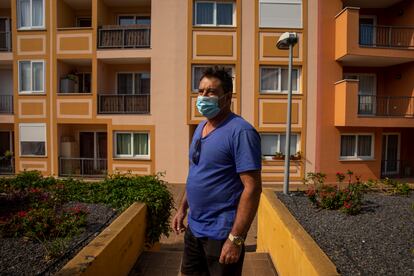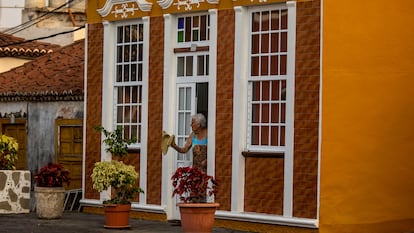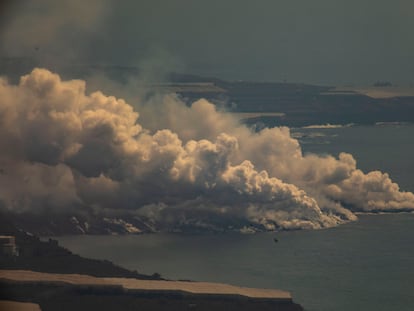Lockdown in La Palma: Like the worst of the pandemic, but with explosions and ash falls
The decision to confine four municipalities near Guirre beach, where lava from the new volcano is falling into the sea, has pushed some locals to leave, while others are concerned about the area’s economic future


The silent and empty streets of the neighborhoods of San Borondón, Marina Alta, Marina Baja and La Condesa are a reminder of the worst days of Spain’s coronavirus lockdown in spring 2020, when millions of people were confined to their homes in an effort to stop the spread of the virus. But there are key differences now: the constant and thunderous explosions of the new volcano on La Palma, and the ash that rains nonstop, covering every crevice in the neighborhood and getting into hair and clothes.

These areas in the coastal municipality of Tazacorte are just a few kilometers away from what used to be Guirre beach, where the lava from the volcano began falling into the sea on Tuesday. Residents in these neighborhoods have been ordered to stay inside due to the risk of toxic gases from the contact of the lava with the seawater. Authorities warn that the air quality is forecast to worsen, particularly on Friday, with a change of winds forecast. Levels of sulfur dioxide rose in Tazacorte and the town of Los Llanos de Ariadne on Thursday, but do not yet represent a “danger to public health,” according to Maria José Blanco, the head of the National Geographic Institute (IGN) in the Canary Islands.
The 300 residents of these four neighborhoods have shut their doors, and many have decided not to reopen them. That’s the case for Enrique Pons, a local from San Borondón born in Vic in Barcelona province, who is loading up his car with the bare essentials and leaving with his family for the capital, Santa Cruz de la Palma, which is on the other side of the Canary Island. “I am going because the cloud of ash is getting closer and closer. And who knows if the gases are going to reach here,” he says, pointing in the direction of the now non-existent Guirre beach, four kilometers away. In his apartment building, he says, without a face mask, few people remain. “In this area, there is a lot of vacation tourism and only a few longtime locals,” he explains.

One of the people who has stayed behind is María Pilar Rodríguez, 70, who lives with her husband and one of her three surviving daughters. “It’s been awful for us,” she says, while leaning on the door. “It’s getting worse and worse. My husband has lung problems and we are confined. It’s just like the pandemic, and worse still, we have had recent deaths in the family. This is a tragedy.”
Antonia María Martín, a smiling elderly woman from the Marina Baja neighborhood, is equally anxious. “I’m truly not doing well,” she says, despite her smile, as she strenuously sweeps the footpath outside her house. “The psychologist comes here every week,” she explains, without letting go of the broom. She had a kidney removed not long ago, and says she has struggled to recover from the operation. She lives with her husband and one of her four sons, the only one who is single. “I am not leaving here for anything. I send them to do the shopping… There was not much going out before, but now there is even less,” she says, adding: “I only ask God for this volcano to stop once and for all.”
Martín will likely have to be patient. Spokespersons from the Volcano Risk Prevention Plan (Pevolca) expressed concern about the air quality on Wednesday, and this is forecast to worsen on Friday with the change in winds. So far, levels have not exceeded the maximums, but residents are recommended to follow safety measures such as the use of face masks, and if possible, remain at home – particularly if they live in Tazacorte, the closest town to where lava is falling into the sea. “The confinement [of the four neighborhoods in Tazacorte] is going to be maintained until it can be proven that the levels are suitable,” explained Rubén Fernández, the technical director of Pevolca.

Residents are also concerned about how confinement will affect business. José Juan Santana is one of the owners of Santana Locksmiths, which is located on the main street of San Borondón. He has just received an order for steel beams and is unloading them onto a truck with the help of Ubay González, a worker at the local steel company Darymar. “We have been confined for four days and we have seen a tremendous drop in business,” explains Santana. His clients are mainly from the banana industry, which dominates the area. “If the banana sector falls, we are all going to fall with it, José,” González tells him. Agriculture directly accounts for 5.4% of the island’s gross domestic product (GDP), but this figure is much higher if exports, packing and the subsidies received from the European Union are considered. EU subsidies are dependent on local companies being able to meet their production quota. And the owners of banana plantations in the area are not optimistic they will be able to do this.
“My bananas are holding on for now,” says Francisco Gómez Acosta, an 80-year-old local from the Marina Alta neighborhood, who has seen three volcanic eruptions in his lifetime. “I have come out to water because I cannot lose all my crops.” His farm is on the other side of the street and he is looking after it himself and with the help of a worker. “I was born poor and I have worked all my life,” he says. “And this wonderful volcano has already screwed up two houses and a greenhouse.”
But not everyone is confident that the bananas will make it. “Look, all these bananas appear healthy, but they are no good. This ash creates stains, and the stains become larger with the bumps of the truck,” says Marco Lorenzo bitterly, on a 5,000-square-meter farm. This farmer is waiting for a truck to help him cut down the bulks of bananas and carry them to a cooperative.
The same thing is happening one kilometer ahead at the crossroads of the Zapata highway between Laguna and Tazacorte. Here, under the supervision of the National Police, a dozen trucks are waiting in line to enter the farms further ahead. The first in line is Alberto, a local truck driver, who like the others, will have 90 minutes to enter with the Civil Guard, load fruit and unload it in a cooperative’s warehouse, then wait in line again for the next delivery. “Of course, we are all worried about our jobs,” he says. “But we have to go on.”
English version by Melissa Kitson.
Tu suscripción se está usando en otro dispositivo
¿Quieres añadir otro usuario a tu suscripción?
Si continúas leyendo en este dispositivo, no se podrá leer en el otro.
FlechaTu suscripción se está usando en otro dispositivo y solo puedes acceder a EL PAÍS desde un dispositivo a la vez.
Si quieres compartir tu cuenta, cambia tu suscripción a la modalidad Premium, así podrás añadir otro usuario. Cada uno accederá con su propia cuenta de email, lo que os permitirá personalizar vuestra experiencia en EL PAÍS.
¿Tienes una suscripción de empresa? Accede aquí para contratar más cuentas.
En el caso de no saber quién está usando tu cuenta, te recomendamos cambiar tu contraseña aquí.
Si decides continuar compartiendo tu cuenta, este mensaje se mostrará en tu dispositivo y en el de la otra persona que está usando tu cuenta de forma indefinida, afectando a tu experiencia de lectura. Puedes consultar aquí los términos y condiciones de la suscripción digital.
More information

Volcanic eruption intensifies in La Palma, increasing ash fall

Lava flowing to sea from La Palma volcano could head off in other directions
Últimas noticias
EU’s prestige at stake with proposal to fund Ukrainian war effort with Russian assets
Mustafa Suleyman: ‘Controlling AI is the challenge of our time’
Venezuela breaks energy agreements with Trinidad and Tobago due to alleged complicity with the US
The murder of Michele and Rob Reiner: A tale of horrific days in Hollywood
Most viewed
- ‘El Limones’ and the growing union disguise of Mexican organized crime
- Christian Louboutin: ‘Young people don’t want to be like their parents. And if their parents wear sneakers, they’re going to look for something else’
- ‘We are dying’: Cuba sinks into a health crisis amid medicine shortages and misdiagnosis
- A mountaineer, accused of manslaughter for the death of his partner during a climb: He silenced his phone and refused a helicopter rescue
- The low-cost creative revolution: How technology is making art accessible to everyone









































